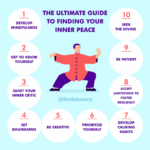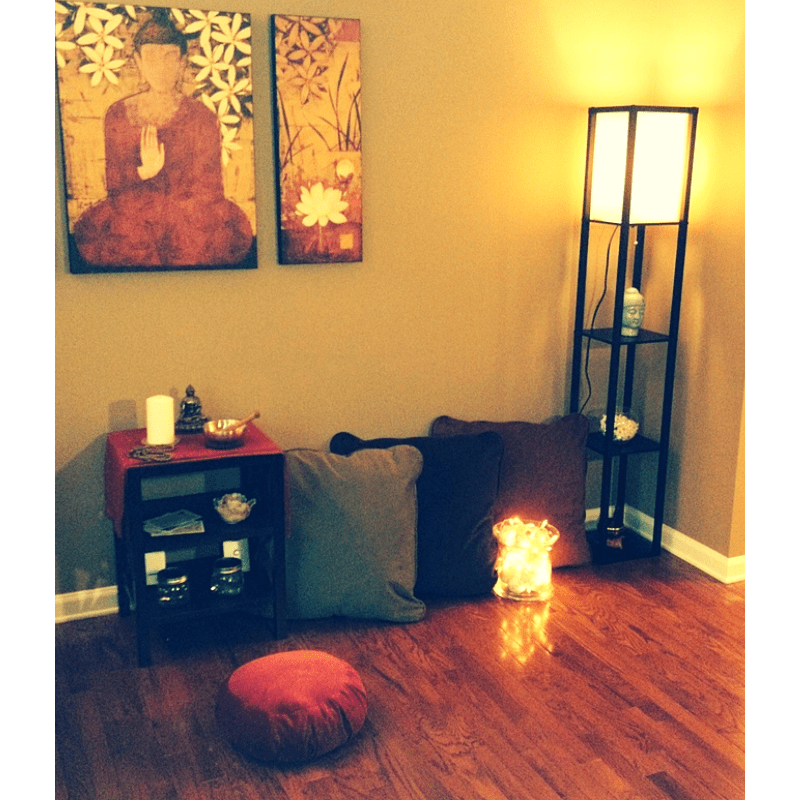Creating a dedicated meditation space can significantly enhance your practice. This beginner’s guide will walk you through the essential steps to setting up a calming and effective environment. We'll explore the ideal location, furniture choices, and the importance of incorporating elements that promote relaxation and focus. From choosing comfortable seating to incorporating natural light and calming scents, this guide will help you transform a corner of your home into a personal sanctuary for mindful practice. Learn how to cultivate a space that nurtures inner peace and supports your meditation journey.
Creating a Sanctuary: Designing Your Ideal Meditation Space
Finding the Right Location
Choosing the right spot for your meditation practice is crucial. Privacy is key; you need a space where you won't be interrupted. Consider a quiet corner of your bedroom, a dedicated room, or even a peaceful spot outdoors (weather permitting). Minimize distractions – this means turning off your phone, dimming the lights, and ensuring the area is relatively clutter-free. The ideal location should evoke a sense of calm and tranquility, allowing you to easily slip into a meditative state.
Setting the Ambiance: Lighting, Scents, and Sounds
The atmosphere plays a significant role in setting the mood for your meditation. Soft, natural light is preferable to harsh overhead lighting. Consider using candles (safely!), a Himalayan salt lamp, or a diffuser with calming essential oils like lavender or chamomile. Subtle background sounds can be beneficial – nature sounds, calming music, or even white noise can help to mask external distractions and promote relaxation. Avoid strong or overpowering scents.
Choosing Your Seating: Comfort and Posture
Your comfort during meditation is paramount. Proper posture is important, but unnecessary stiffness can hinder your practice. Experiment with different seating options – a cushion on the floor, a meditation bench, or even a comfortable chair. The key is to find a position that supports your spine without causing strain. Experiment to discover what works best for your body type and preferences.
Essential Accessories: Enhancing Your Practice
While not strictly necessary, certain accessories can enhance your meditation experience. A meditation cushion or zabuton provides comfortable seating and support for proper posture. A mala beads can help with focus and counting breaths. A small altar or symbolic items that hold personal meaning can enhance the spiritual aspect of your practice. Choose items that resonate with you and contribute to a sense of peace and intentionality.
Maintaining Your Space: Ritual and Cleanliness
Consistency in maintaining your meditation space is important. Keep the area clean and organized to foster a sense of calm. Develop a simple ritual for preparing your space before each meditation session. This could be as simple as lighting a candle, opening a window for fresh air, or spending a few moments clearing your mind. This ritual helps signal your mind and body that it’s time to relax and focus.
| Aspect | Considerations |
|---|---|
| Location | Privacy, quiet, minimal distractions |
| Ambiance | Soft lighting, calming scents, soothing sounds |
| Seating | Comfort, proper posture, support |
| Accessories | Cushion, mala beads, altar (optional) |
| Maintenance | Cleanliness, consistent preparation ritual |
How to create your own meditation space?

Creating Your Own Meditation Space
How to Create Your Own Meditation Space
1. Choosing the Right Location
Selecting the perfect spot for your meditation space is crucial. It needs to be a place where you feel safe, comfortable, and undisturbed. Consider factors like natural light, ambient noise, and temperature. A quiet corner in your bedroom, a dedicated room, or even a peaceful spot outdoors can all work, depending on your preferences and living situation. The key is to find a location that promotes relaxation and minimizes distractions.
- Privacy: Ensure minimal interruptions from family members, pets, or household noises.
- Comfort: The space should be neither too hot nor too cold, and well-ventilated.
- Ambiance: Consider natural light, calming colors, and the overall feel of the space.
2. Setting the Ambiance
Once you've found your location, it's time to cultivate the right ambiance. This involves creating a soothing and peaceful atmosphere that encourages relaxation and introspection. Think about incorporating elements that appeal to your senses. Soft lighting, calming colors on the walls, and pleasant aromas from essential oil diffusers or candles can all contribute to a tranquil environment. Remember, the goal is to create a space that feels uniquely yours and conducive to meditation.
- Lighting: Use soft, warm lighting – candles, lamps, or salt lamps are excellent options.
- Scents: Introduce calming scents like lavender, chamomile, or sandalwood using essential oils or incense (ensure proper ventilation).
- Sounds: Consider using nature sounds, calming music, or a white noise machine to mask distracting noises.
3. Furnishing Your Space
The furniture you choose should support your comfort and posture during meditation. A comfortable cushion or meditation bench is essential. Ergonomics are key; you want to be able to sit comfortably for an extended period without strain. Avoid clutter; a clean and organized space will help you focus your mind. You might also include items that inspire you spiritually or emotionally, such as crystals, plants, or religious icons.
- Seating: Invest in a comfortable cushion, zafu, or meditation bench that supports good posture.
- Minimalism: Keep the space clutter-free to minimize distractions and promote mental clarity.
- Personal Touches: Incorporate items that inspire peace and tranquility – plants, artwork, or meaningful objects.
4. Incorporating Natural Elements
Connecting with nature can significantly enhance your meditation practice. Bringing natural elements into your space can create a sense of calm and grounding. This could include placing potted plants, fresh flowers, or even a small water feature. Natural materials like wood or bamboo can also add to the overall ambiance. The presence of nature can help you connect with your inner peace and promote a sense of well-being.
- Plants: Add potted plants or flowers to bring life and freshness into the space.
- Natural Materials: Use natural materials like wood, bamboo, or stone in your decor.
- Natural Light: Maximize natural light whenever possible to create a brighter and more invigorating space.
5. Maintaining Your Space
Once you’ve created your meditation space, it's crucial to maintain its tranquility and cleanliness. Regularly clean and declutter the area to prevent it from becoming a source of stress or distraction. Take time to appreciate the space you've created and make adjustments as needed. Remember, your meditation space is a sanctuary; treat it with respect and care to ensure it remains a haven for your practice.
- Regular Cleaning: Keep the space clean and organized to maintain a sense of peace and tranquility.
- Decluttering: Regularly remove any unnecessary items to minimize distractions.
- Maintenance: Regularly check and maintain any equipment, such as lamps or diffusers.
How to set a place for meditation?

How to Set a Place for Meditation
How to Set a Place for Meditation
Creating a dedicated meditation space can significantly enhance your practice. It provides a consistent environment that your mind associates with stillness and inner peace, making it easier to slip into a meditative state. The key is to make it a place where you feel comfortable, safe, and free from distractions. This doesn't require a large or extravagant space; even a small corner can be transformed into a sanctuary for your practice. Consider the elements below to design a space that best supports your needs.
1. Location and Ambiance
The ideal location for your meditation space is somewhere quiet and peaceful, away from the hustle and bustle of daily life. This could be a spare room, a corner of your bedroom, or even outdoors under a tree. Minimize noise and visual distractions as much as possible. A soft, calming ambiance is crucial. You can achieve this through:
- Soft Lighting: Use dim lamps, candles (with caution!), or string lights to create a warm and inviting atmosphere.
- Natural Light: If possible, choose a space with natural light, particularly during the day.
- Pleasant Scents: Use essential oil diffusers with calming scents like lavender or chamomile, or simply open a window to let in fresh air.
2. Comfortable Seating and Posture
Your comfort during meditation is paramount. Choose a comfortable seat that allows you to sit upright with ease. This could be a meditation cushion, a chair with good back support, or even a comfortable floor pillow. Experiment to find what works best for your body. Maintain good posture – sitting upright, but not rigid, with your spine straight and your shoulders relaxed.
- Support Your Back: Ensure your back is supported, whether it's through a cushion, chair, or leaning against a wall.
- Proper Leg Position: Your legs should be comfortable and stable. Cross-legged on a cushion, in a chair, or with your legs extended are all options.
- Experiment with Positions: Try different positions to find what's most comfortable and helps you maintain focus.
3. Minimizing Distractions
One of the biggest challenges in meditation is dealing with distractions. Creating a distraction-free environment is key. This means turning off electronic devices, minimizing visual clutter, and potentially using noise-canceling headphones or earplugs to block out external sounds. The goal is to create a space that encourages inward focus.
- Turn off electronics: Put your phone, computer, and television out of sight and on silent.
- Declutter the space: A clean and organized environment promotes clarity and focus.
- Manage external noise: Use earplugs, white noise, or nature sounds to mask distracting sounds.
4. Adding Personal Touches
Personalizing your space makes it feel more like your own sanctuary. Incorporate items that inspire you and promote relaxation. This could include inspirational quotes, meaningful objects, crystals, plants, or artwork that brings you peace and joy. These visual cues can help you center yourself and prepare for meditation.
- Meaningful Objects: Include objects that hold personal significance and evoke a sense of calm.
- Nature Elements: Plants or natural materials can bring a sense of peace and connection to nature.
- Visual Aids: Pictures, artwork, or inspirational quotes can help set the tone.
5. Maintaining Your Space
Once you've created your meditation space, it's important to maintain it. Regularly clean and declutter the area to keep it feeling fresh and inviting. This simple act of upkeep reinforces the intention of creating a sacred space dedicated to your well-being. Treat this space with respect and care; it's an investment in your inner peace.
- Regular Cleaning: Keep the space tidy and dust-free.
- Decluttering: Regularly remove any items that no longer serve their purpose.
- Respect the Space: Treat your meditation space with reverence and intention.
How to structure a meditation session?

Structuring a Meditation Session
How to Structure a Meditation Session
Finding a Comfortable Posture
Posture is key to a successful meditation session. It shouldn't be so rigid that you're uncomfortable, but not so relaxed that you fall asleep. The goal is to find a balance that allows for stillness and alertness. Experiment with different positions to find what works best for you. Whether sitting on a cushion, using a chair, or even lying down (though lying down increases the risk of falling asleep), ensure your spine is relatively straight, shoulders relaxed, and your head balanced. Avoid crossing your legs if it causes discomfort.
- Sit upright with your spine straight but not stiff.
- Relax your shoulders and let your arms rest comfortably in your lap.
- Keep your chin slightly tucked to align your neck and spine.
Setting Your Intention
Before you begin, take a moment to set an intention. What do you hope to gain from this meditation session? Are you seeking calm, clarity, self-compassion, or something else? Having a clear intention can help focus your mind and guide your practice. It doesn’t need to be elaborate; a simple phrase or word can be sufficient. This sets the tone for your meditation and ensures you're actively participating rather than passively drifting.
- Consider your current state of mind and what you need most.
- Choose a single word or short phrase that represents your intention (e.g., "peace," "calm," "focus").
- Repeat this intention silently to yourself a few times before beginning.
Focusing Your Attention
Once you've established your posture and intention, you need a focus point. This is crucial for keeping your mind from wandering. Common focus points include the breath, a mantra (repeated word or phrase), or a specific sensory experience like a sound or body sensation. Choose a focus that resonates with you and gently redirect your attention back to it whenever your mind wanders (which it inevitably will). Don't judge yourself for these distractions; simply acknowledge them and return to your chosen focus.
- Focus on the sensation of your breath entering and leaving your body.
- Repeat a mantra silently to yourself, such as "peace" or "calm."
- Concentrate on a specific sound, such as the ticking of a clock or the sound of rain.
Guided Meditation or Self-Guided?
Decide whether you want to use a guided meditation or practice self-guided meditation. Guided meditations, often found in apps or online, offer structure and voice prompts to help you stay focused. Self-guided meditation requires more self-discipline but allows for greater freedom and personal exploration. Both methods are valuable; experimenting with both can help you determine your preference and improve your meditation practice. The key is consistency, regardless of the method used.
- Explore guided meditation apps or online resources for structured sessions.
- Practice self-guided meditation by focusing on your breath, body sensations, or a mantra.
- Experiment with both approaches to find what suits your style and needs best.
Ending the Session
Gradually bring the meditation to a close. Don't abruptly end the session. Take a few moments to gently bring your awareness back to your surroundings. Notice the sounds, sensations, and thoughts that arise. Feel your body and take a few deep breaths. This transition helps you integrate the benefits of meditation into your daily life and prevents feelings of disorientation. Reflect on your experience, noting any insights or shifts in your emotional state. It's often helpful to maintain a journal.
- Take several slow, deep breaths, noticing the sensation of the breath in your body.
- Gently wiggle your fingers and toes, becoming aware of your physical body.
- Open your eyes slowly, taking a moment to appreciate the present moment.
What should a meditation room look like?

What Should a Meditation Room Look Like?
A meditation room should be a sanctuary, a space designed to promote relaxation, focus, and inner peace. The ideal aesthetic is highly personal, but there are some key elements that contribute to creating a conducive environment. Generally, the room should feel calm, quiet, and free from distractions. Minimalism is key, allowing your mind to settle without the visual clutter of everyday life. Natural light is preferred, though adjustable lighting is useful for different times of day and moods. Consider the use of natural materials like wood and stone to create a sense of grounding and connection to nature. The overall atmosphere should be inviting and conducive to introspection and stillness, encouraging a sense of comfort and safety.
Lighting for a Meditation Room
Lighting plays a crucial role in setting the mood of your meditation space. Soft, diffused natural light is ideal, but this might not always be feasible. Therefore, incorporate adjustable lighting options to cater to different times of the day and personal preferences. Avoid harsh overhead lighting, as it can be jarring and disruptive. Instead, opt for warmer, gentler light sources such as salt lamps, candles (with proper safety precautions), or dimmable LED lights. The goal is to create a calming, non-stimulating environment that promotes relaxation and focus.
- Natural Light: Prioritize large windows allowing ample natural light when possible.
- Dimmable Artificial Light: Use dimmable LED lights or lamps that allow you to adjust the brightness.
- Warm-Colored Lighting: Opt for warmer color temperatures (around 2700K) for a more relaxing ambiance.
Color Palette and Decor for a Meditation Room
The colors you choose for your meditation room significantly impact its atmosphere. Soft, muted tones are generally recommended, such as pastels, earth tones, or calming blues and greens. These colors are associated with peace, tranquility, and relaxation. Avoid overly bright or stimulating colors that could be distracting. Keep the décor minimal. A few carefully chosen items can enhance the space without overwhelming it. This could include a small plant, a piece of artwork that inspires you, or a simple, comfortable cushion.
- Muted Tones: Choose calming colors like pale blues, greens, or beige.
- Minimalist Decor: Avoid clutter; a few meaningful items are sufficient.
- Natural Elements: Incorporate natural materials like wood or stone for a grounding effect.
Sound and Acoustics in a Meditation Room
Sound is a powerful influence on our state of mind. Minimize external noise as much as possible to create a peaceful atmosphere. This might involve soundproofing the room, using noise-canceling headphones, or using a white noise machine or nature sounds to mask distracting sounds. The acoustics of the room should be considered; excessive reverberation can be disruptive. Soft furnishings, such as rugs and cushions, can help to absorb sound and create a more peaceful environment.
- Soundproofing: Reduce external noise as much as possible.
- Sound Masking: Use white noise, nature sounds, or calming music to mask distractions.
- Acoustic Treatment: Consider adding rugs, curtains, or other sound-absorbing materials.
Furniture and Seating for a Meditation Room
The furniture in your meditation room should be comfortable and supportive. A comfortable cushion or meditation bench is essential, allowing you to sit upright with good posture without discomfort. Avoid overly soft or sinking furniture that might make it difficult to maintain proper posture. You might also include a small table or shelf for items such as candles, incense, or a mala beads. The space should feel inviting and welcoming, allowing you to relax and focus without distractions.
- Comfortable Seating: Choose a cushion, bench, or chair that supports good posture.
- Minimal Furniture: Keep the furniture to a minimum to avoid clutter.
- Supporting Items: Include a small table for candles, incense, or other meditation aids.
Temperature and Air Quality for a Meditation Room
The temperature and air quality of your meditation room greatly influence comfort and focus. A comfortable temperature is essential, neither too hot nor too cold. Good ventilation is also important to ensure fresh, clean air. Consider using an air purifier to remove dust, pollen, and other airborne irritants. A gentle breeze or the scent of calming essential oils (used safely and sparingly) can enhance the overall atmosphere. The goal is to create an environment that feels both calming and invigorating.
- Comfortable Temperature: Maintain a comfortable temperature for relaxation.
- Fresh Air: Ensure good ventilation or use an air purifier.
- Pleasant Scents (Optional): Use calming essential oils sparingly.
Frequently Asked Questions
Do I need a special room for my meditation space?
Absolutely not! While a dedicated space is ideal, you don't need a whole room. A quiet corner in your bedroom, a peaceful spot in your living room, or even outdoors under a tree can work perfectly. The most important factor is finding a place where you feel comfortable and undisturbed.
What items are essential for my meditation space?
The essentials are surprisingly minimal. A comfortable cushion or chair is key for good posture. You might also find a soft blanket helpful, especially if you get cold easily. Some people prefer a small altar with meaningful objects, but this is entirely optional. The most essential element is your intention to create a peaceful and calming atmosphere.
How can I make my meditation space feel calming and peaceful?
Consider incorporating elements that promote relaxation. Soft lighting (candles, lamps, or even natural light) is great. Natural scents like lavender or sandalwood can help. Soft music or nature sounds can be soothing. Declutter the space to eliminate visual distractions and create a sense of order and cleanliness. Most importantly, personalize it to reflect your own sense of peace and tranquility.
How much time should I dedicate to setting up my meditation space?
There's no right or wrong answer. Some people spend hours meticulously curating their space, while others create a simple and functional setup in minutes. The key is to create a space that feels inviting and comfortable for you. Don't feel pressured to make it perfect; start small and add elements gradually as you discover what works best for your practice.
 Deep Meditation: Unlock Your Inner Peace
Deep Meditation: Unlock Your Inner Peace Finding Serenity: Meditation for Busy Minds
Finding Serenity: Meditation for Busy Minds A Checklist for Setting Up Your Meditation Space
A Checklist for Setting Up Your Meditation Space How to Create a Relaxing Meditation Space
How to Create a Relaxing Meditation SpaceIf you want to know other articles similar to A Beginner’s Guide to Setting Up Your Meditation Space you can visit the Meditation and Relaxation category.

